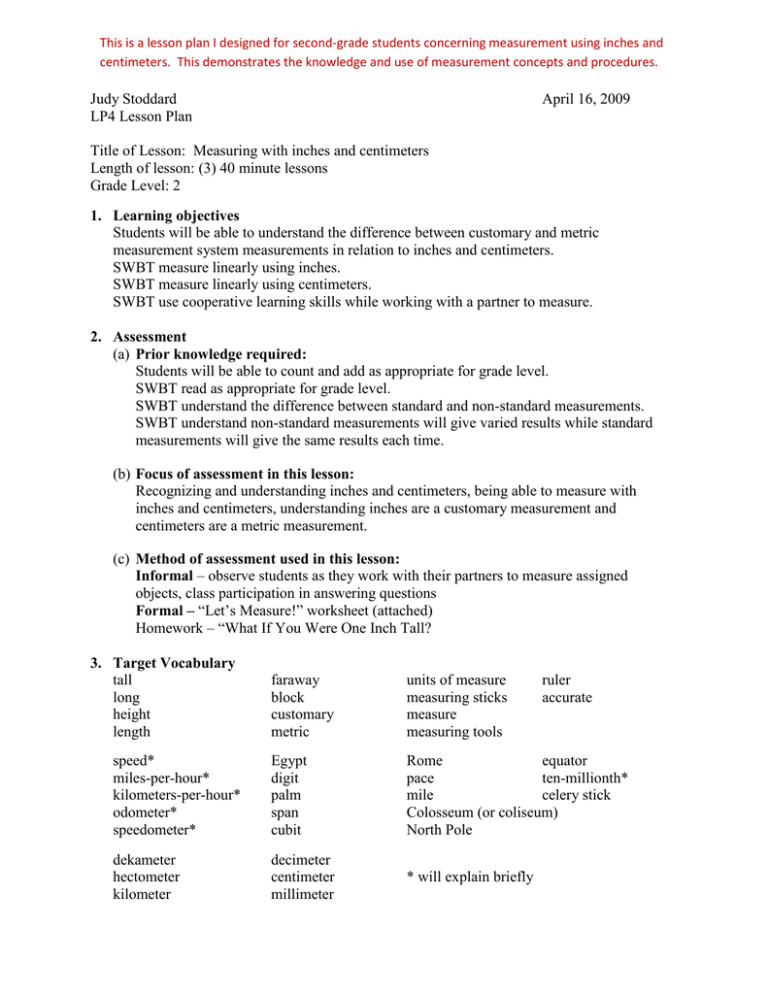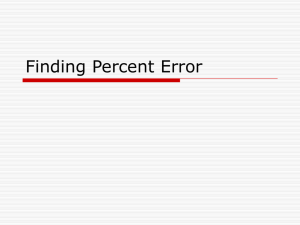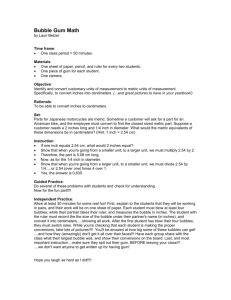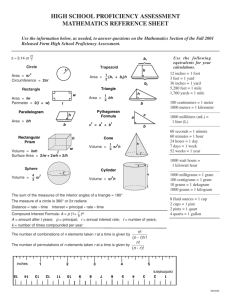This is a lesson plan I designed for second
advertisement

This is a lesson plan I designed for second-grade students concerning measurement using inches and centimeters. This demonstrates the knowledge and use of measurement concepts and procedures. Judy Stoddard LP4 Lesson Plan April 16, 2009 Title of Lesson: Measuring with inches and centimeters Length of lesson: (3) 40 minute lessons Grade Level: 2 1. Learning objectives Students will be able to understand the difference between customary and metric measurement system measurements in relation to inches and centimeters. SWBT measure linearly using inches. SWBT measure linearly using centimeters. SWBT use cooperative learning skills while working with a partner to measure. 2. Assessment (a) Prior knowledge required: Students will be able to count and add as appropriate for grade level. SWBT read as appropriate for grade level. SWBT understand the difference between standard and non-standard measurements. SWBT understand non-standard measurements will give varied results while standard measurements will give the same results each time. (b) Focus of assessment in this lesson: Recognizing and understanding inches and centimeters, being able to measure with inches and centimeters, understanding inches are a customary measurement and centimeters are a metric measurement. (c) Method of assessment used in this lesson: Informal – observe students as they work with their partners to measure assigned objects, class participation in answering questions Formal – “Let’s Measure!” worksheet (attached) Homework – “What If You Were One Inch Tall? 3. Target Vocabulary tall long height length faraway block customary metric units of measure measuring sticks measure measuring tools ruler accurate speed* miles-per-hour* kilometers-per-hour* odometer* speedometer* Egypt digit palm span cubit Rome equator pace ten-millionth* mile celery stick Colosseum (or coliseum) North Pole dekameter hectometer kilometer decimeter centimeter millimeter * will explain briefly 4. Materials (a) Book – How Tall How Short How Faraway (b) Books, table tops, crayons, pencils, doorway, chair, desks (all items students will measure) (c) Ruler with inches and centimeters for each student (d) The worksheet “Let’s Measure!” – two for each group of 2 (attached) (e) Homework – “If I Were One Inch Tall” (attached) (f) Bag and following items in the bag (for extension activity) – comb, marker, pen, piece of cardboard, string, paperclip, popsicle stick (g) “Measurement match” worksheet (attached) 5. Lesson Process (a) Introduction (Engage) 40 minutes The teacher will ask questions such as, “What do we mean when we say the word measure?” “What does length mean?” “What are some ways we can measure length?” “What can you tell me about inch?” “What can you tell me about centimeter?” “Do you think inches and centimeters are the same size?” “What do we use a ruler for?” “How do you think people used to measure a long time ago?” “Do any of you know how tall you are?” Conversation will vary based on student responses. The teacher will do a picture walk of the book How Tall How Short How Faraway by David A. Adler. The teacher can ask questions of the students based on the pictures such as why do you think the book is showing different body parts? The children can make predictions of what the book is about. The teacher can ask if anyone knows how tall they are. The teacher can then read the book. Geography can be incorporated as Egypt and Rome are mentioned in the book. Vocabulary words from the book (listed above) will be listed on the board. As the book is read the vocabulary words can be pointed out and discussed. Possible differentiation For visually impaired, copies of the books can be given individually to students. The list of vocabulary words can be copied for students. Children can also be given the opportunity at a later time to look over the book again, if needed. Showing the book on the Elmo, having the children use their own body parts to demonstrate spans, digits, and so forth, will be helpful for visual learners. This will also reinforce the lesson for the entire class. (b) Learning procedures relating to objectives/Core (Explore) 40 minutes How would the students be grouped The students will work with partners (heterogeneous groups of 2) Description of the task The students will use the “Let’s Measure!” worksheet. Each group will receive 2 rulers with centimeters and inches with which to measure the objects listed on the worksheet. The teacher will explain the process of measuring with the different objects. The teacher can illustrate by measuring several sample objects at the front of the room while pointing out the need of correct placement of the ruler for accurate measurement. Both group members will have their own sheet to record measurements on in order to practice writing and recording information in a columnar form. Group members will work together to measure. Team members will, most likely, have the same answer for a particular object’s length measurement. Students should estimate using words, such as ‘about’ or ‘almost’ when measured objects are not exactly an even number of the unit being used to measure. If any group finishes early they can measure additional objects. Object name(s) and length should be listed at the available space on the “Let’s Measure!” worksheet. Homework – Teacher will go over directions with the students. Class can read over poem together. Questions that support students’ thinking As the groups are working on measuring, the teacher should walk around the room to make sure each group is measuring correctly. If not, the teacher should ask questions, such as, “How do you think you will get the most accurate measurement using the ruler?” “Should you place the ruler even with the end of the object you are measuring? If the students understand measurement methods the teacher can let the students work on their own. The students may need an occasional reminder to focus on the task. Product/outcome expected at the end of the core Completed “Let’s Measure” worksheet Completed Homework – “If I Were One Inch Tall” Differentiation of the task and/or the product o For students with physical disabilities: Students can work with a partner that is not limited physically. Depending on the disability, the student can write the measurement information, do the measuring, and/or make suggestions of how and what to measure. If necessary the student can record the information using the computer. o For students with learning disabilities: Since the “Let’s Measure!” worksheet is very simple, no adjustments need to be made to the worksheet in format. The number of objects listed to be measured can be lessened. For ELL learners, this activity is hands-on, which will help them to understand the task. If the student is unfamiliar with an object’s name, their partner can tell them what it is. o For students who are gifted or talented: If students finish early, they can measure additional objects in the room. If additional space is needed, students can use the back of their worksheets to write objects and their measurements. Content AND Process Standards targeted in the core (From NYS Standard 3: Mathematics) Content Measurement Strand 2.N.2 Use a ruler to measure standard units (whole inches) Processes Problem Solving 2.PS.1 Explore, examine, and make observations about a social problem or mathematical situation 2.PS.2 Interpret information correctly, identify the problem, and generate possible solutions Reasoning and Proof 2.RP.2 Recognize that mathematical ideas need to be supported by evidence 2.RP.3 Investigate the use of knowledgeable guessing as a mathematical tool Connections 2.CN.7 Recognize the presence of mathematics in their daily lives Representation 2.R.3 Use standard and nonstandard representations (c) Conclusion/Closing (Explain, Elaborate) 40 minutes The teacher will lead a conversation on the results the students came up with on their “Let’s Measure” worksheet. The teacher can have a copy of the worksheet on the overhead projector and ask for several measurements for the different items that were to be measured. Customary and metric measuring can be discussed. Questions that promote students’ reflection on the activity/task Which measuring method(s) do you think are the most accurate? (Both standard methods, customary and metric, do not vary. Both will give accurate results.) From How Tall How Short How Faraway which measuring method(s) do you think might give different people different results? (Egyptian method. Also using any object that may vary in length) Which measurement system do you think is the best way of measuring? Why? (customary or metric – may say inches because they may be more familiar with them. May, however, say centimeter because based on 10) Questions that promote students’ connection of ideas How will knowing how to measure help you? (If need to know how long something is in order to purchase the right size, can see what items will fit in what spaces) When is it important to know how tall you are? (amusement rides, car seats) Summary of the new findings, concepts and/or procedures The teacher can conclude that there are different ways of measuring the length of a particular object. The object stays the same length, but the length of the units we use to measure the object is what changes. The teacher can summarize standard, nonstandard, customary, and metric measuring. The teacher can ask the students, “Who can show me how they used the ruler to measure a crayon in centimeters?” “What did you learn about measurement?” (It is important to be accurate to get the best result, there are different ways to measure (some are better than others), we can estimate lengths) As the students are responding the teacher can write the information on the overhead. The height of the students can be taken off their “Let’s Measure!” worksheet. Children can assist in deciding where in the line each of them will stand according to the measurements taken. This is a good activity for comparing number values (less than, greater than) while seeing if the students measured accurately. The students can see how accurate they were with their measurements (chances are the students will not be in the exact order of height). The teacher can then lead a discussion asking the students why they think there were differences between what they have discovered and the measurements from the worksheets. The importance of measuring techniques to accurate measurements can be discussed. All children in the class should contribute to the discussion of the lesson to the best of their ability. Content and/or Process Standards targeted in the closing (From NY State Standard 3: Mathematics) Problem Solving 2.PS.1 Explore, examine, and make observations about a social problem or mathematical situation 2.PS.7 Compare and discuss ideas for solving a problem with teacher and/or students to justify their thinking 2.PS.10 Explain to others how a problem was solved, giving strategies and justifications. 2.RP.6 Develop and explain an argument verbally or with objects 2.RP.7 Listen to and discuss claims other students make Communication 2.CM.1 Understand how to organize their thought processes 2.CM.2 Verbally support their reasoning and answer 2.CM.4 Listen to solutions shared by other students Connections 2.CN.7 Recognize the presence of mathematics in their daily lives 6. “If time”/extensions Students are to open the bag and put the objects on the activity table. The students are to measure the various items in order to fill match the objects with their correct measurements on the activity sheet. (attached) Students can work with their measuring partners or work alone. 7. References Adler, D. (1999). How Tall How Short How Faraway. New York: Holiday House. OCM BOCES Science Center Measurement Unit 2008. Name _______________________________________ Date ______________________ Let’s Measure! Measure the following items. Use the ruler to measure with inches and then centimeters. Write the measurements in the correct space. Object Inches Centimeters Pencil Notebook Paper Desk Height Crayon Digit Cubit Seat of a chair book Your height To measure with customary units, we use (circle one) To measure with metric units, we use (circle one) inches inches or or centimeters centimeters Name _______________________________________ Date ______________________ What if you were one inch tall? Read the poem by Shel Silverstein, then write 3-5 sentences explaining how you would feel if you were one inch tall. “One Inch Tall” By Shel Silverstein If you were only one inch tall, you’d ride a worm to school. The teardrop of a crying ant would be your swimming pool. A crumb of cake would be a feast And last you seven days at least, A flea would be a frightening beast If you were one inch tall. If you were only one inch tall, you’d walk beneath the door, And it would take about a month to get down to the store. A bit of fluff would be your bed, You’d swing upon a spider’s thread, And wear a thimble on your head If you were one inch tall. You’d surf across the kitchen sink upon a stick of gum, You couldn’t hug your mama, you’d just have to hug her thumb. You’d run form people’s feet in fright, To move a pen would take all night, (This poem took fourteen years to write – ‘Cause I’m just one inch tall). ______________________________________________________________________________ ______________________________________________________________________________ ______________________________________________________________________________ ______________________________________________________________________________ ______________________________________________________________________________ ______________________________________________________________________________ ______________________________________________________________________________ Name _______________________________________ Date ______________________ Measurement Match Take all items out of the bag and place on the table. Measure each item. Draw a line from the item to the correct measurement. comb 13 cm marker 2 inches pen 12 cm cardboard 18 cm string 6 inches paperclip 4 inches popsicle stick 11 cm Name _______________________________________ Measurement Match Date ______________________ Answer Key Take all items out of the bag and place on the table. Measure each item. Draw a line from the item to the correct measurement. comb 13 cm marker 2 inches pen 12 cm cardboard 18 cm string 6 inches paperclip 4 inches popsicle stick 11 cm






